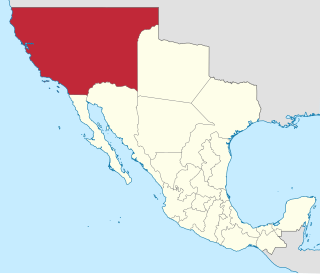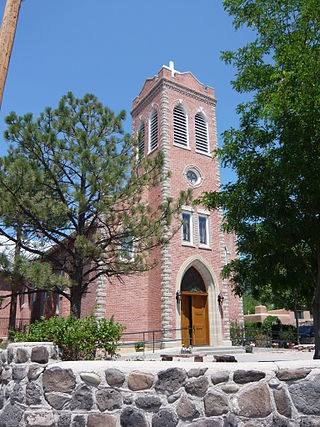Related Research Articles

Alta California, also known as Nueva California among other names, was a province of New Spain formally established in 1804. Along with the Baja California peninsula, it had previously comprised the province of Las Californias, but was made a separate province in 1804. Following the Mexican War of Independence, it became a territory of Mexico in April 1822 and was renamed Alta California in 1824.
San Juan, Spanish for Saint John, most commonly refers to:
Santa Cruz or Santacruz may refer to:

The Southwestern United States, also known as the American Southwest or simply the Southwest, is a geographic and cultural region of the United States that includes Arizona and New Mexico, along with adjacent portions of California, Colorado, Nevada, Oklahoma, Texas, and Utah. The largest cities by metropolitan area are Phoenix, Las Vegas, El Paso, Albuquerque, and Tucson. Before 1848, in the historical region of Santa Fe de Nuevo México as well as parts of Alta California and Coahuila y Tejas, settlement was almost non-existent outside of Nuevo México's Pueblos and Spanish or Mexican municipalities. Much of the area had been a part of New Spain and Mexico until the United States acquired the area through the Treaty of Guadalupe Hidalgo in 1848 and the smaller Gadsden Purchase in 1854.
San Miguel, Spanish for Saint Michael, may refer to:
Guadalupe or Guadeloupe may refer to:
Santa Rosa is the Italian, Portuguese, and Spanish name for Saint Rose.
Cottonwood or cotton wood may refer to:
San Antonio is the seventh-most populous city in the United States and the second-most populous in the state of Texas.

The Old Spanish Trail is a historical trade route that connected the northern New Mexico settlements of Santa Fe, New Mexico with those of Los Angeles, California and southern California. Approximately 700 mi (1,100 km) long, the trail ran through areas of high mountains, arid deserts, and deep canyons. It is considered one of the most arduous of all trade routes ever established in the United States. Explored, in part, by Spanish explorers as early as the late 16th century, the trail was extensively used by traders with pack trains from about 1830 until the mid-1850s. The area was part of Mexico from Mexican independence in 1821 to the Mexican Cession to the United States in 1848.

The Ute Mountain Ute Tribe is one of three federally recognized tribes of the Ute Nation, and are mostly descendants of the historic Weeminuche Band who moved to the Southern Ute reservation in 1897. Their reservation is headquartered at Towaoc, Colorado on the Ute Mountain Ute Indian Reservation in southwestern Colorado, northwestern New Mexico and small sections of Utah.

Ohkay Owingeh, known by its Spanish name as San Juan Pueblo from 1589 to 2005, is a pueblo in Rio Arriba County, New Mexico. For statistical purposes, the United States Census Bureau has defined that community as a census-designated place (CDP). Ohkay Owingeh is also the federally recognized tribe of Pueblo people inhabiting the town.

America's 11 Most Endangered Places or America's 11 Most Endangered Historic Places is a list of places in the United States that the National Trust for Historic Preservation considers the most endangered. It aims to inspire Americans to preserve examples of architectural and cultural heritage that could be "relegated to the dustbins of history" without intervention.
The following is a set–index article, providing a list of lists, for the cities, towns and villages within the jurisdictional United States. It is divided, alphabetically, according to the state, territory, or district name in which they are located.

The Domínguez–Escalante Expedition was a Spanish journey of exploration conducted in 1776 by two Franciscan priests, Atanasio Domínguez and Silvestre Vélez de Escalante, to find an overland route from Santa Fe, New Mexico, to their Roman Catholic mission in Monterey, on the coast of modern day central California. Domínguez, Vélez de Escalante, and Bernardo de Miera y Pacheco, acting as the expedition's cartographer, traveled with ten men from Santa Fe through many unexplored portions of the American West, including present-day western Colorado, Utah, and northern Arizona. Along part of the journey, they were aided by three indigenous guides of the Timpanogos tribe.

The following is an alphabetical list of articles related to the U.S. state of New Mexico.

The Trail of the Ancients is a collection of National Scenic Byways located in the U.S. Four Corners states of Utah, Colorado, New Mexico, and Arizona. These byways comprise:
References
- ↑ Davis, Lucile (2003). The Caddo of Texas. Rosen Publishing. p. 5. ISBN 9780823964352.
- ↑ Carvajal, Guillermo (January 13, 2014). El Desconocido Origen Español del Nombre de Ocho Estados de Norteamérica [The unknown Spanish origin of the name of eight States of North America].ABC. Archived from the original on June 3, 2016. Retrieved January 16, 2021.
- ↑ Bright, William (2004). Native American placenames of the ... - William Bright - Google Libros. ISBN 9780806135984 . Retrieved 2011-11-12.
- ↑ Walter Romig, Michigan Place Names, p. 86
- ↑ Walter Romig, Michigan Place Names, p. 187